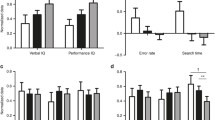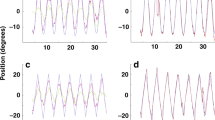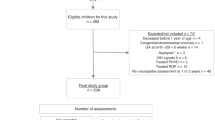Abstract
This paper represents a review of the research that focuses on a population of strong clinical interest on a national and international scale—infants born with low birth weight (LBW). Among the numerous developmental deficits commonly associated with this group, one of the most frequently cited problems is poor fine- and visual-motor integration. In addition to the direct perceptual-motor development concern, the literature provides a reasonable case that such deficits place this population at increased risk for subnormal academic performance and difficulties with specific daily living (self-help) activities. By assessing the infant at an early age and designing specific strategies for intervention, clinical psychologists can play a major role in improving fine- and visual-motor behavior in this population.
Similar content being viewed by others
REFERENCES
Andraca, I., Pino, P., de La Parra, A., Rivera, F., & Castillo, M. (1998). Factores de riesgo para el desarrollo psicomotor en lactantes nacidos en optimas condiciones biologicas (Risk factors for psychomotor development among infants born under optimal biological conditions). Rev. Saude Publica, 32(2), 138–147.
Becker, P., Grunwald, P., & Brazy, J. (1999). Motor organization in very low birth weight infants during caregiving: Effects of a developmental intervention. Developmental and Behavioral Pediatrics, 20(5), 344–354.
Beery, K. (1989). Developmental test of visual–motor integration (3rd ed.). Cleveland: Modern Curriculum Press.
Beery, K. (1997). The Beery–Buktencia developmental test of visualmotor integration (4th ed.). Parsippony, NJ: Modern Curriculum Press.
Brooks–Gunn, J., Liaw, F., & Klebanov, P. K. (1992). Effects of early intervention on cognitive function of low birth weight preterm infants. Journal of Pediatrics, 120, 350–359.
Case–Smith, J. (1996). Analysis of current motor development theory and recently published infant motor assessments. Infant and Young Children, 9(1), 29–41.
Case–Smith, T., & Bigsby, R. (2000). Posture and fine–motor assessment of infants. San Antonio, TX: The Psychological Corporation.
Dammann, O., Walther, H., Allers, B., Schroder, M., Drescher, J., Lutz, D., Veelken, N., & Schulte, F. (1996). Development of a regional cohort of very–low birthweight children at six years: Cognitive abilities are associated with neurological disability and social background. Developmental Medicine and Child Neurology, 38, 97–108.
Ericson, A., & Kallen, B. (1998). Very low birth weight boys at the age of 19. Archives of Disease in Childhood Fetal and Neonatal Edition, 78(3), F171–F174.
Folio, R., & Fewell, R. (2000). Peabody Developmental Motor Scales. Austin, TX: Pro–ed.
Goyen, T. A., Lui, K., & Woods, R. (1998). Visual–motor, visualperception, and fine motor outcomes in very–low–birthweight children at 5 years. Developmental Medicine and Child Neurology, 40(2), 76–81.
Granthammcgregor, S. M., Lira, P. I. C., Ashworth, A., Morris, S. S., & Assuncao, A. M. S. (1998). The development of low birth weight term infants and the effects of the environment in Northeast Brazil. Journal of Pediatics, 132(4), 661–666.
Hack, M., Klein, N., & Taylor, H. (1995). Long–term developmental outcomes of low birth weight infants. In R. E. Behrman (Ed.), The future of children (pp. 176–196). United States of America: Center for the Future of Children, The David and Lucile Packard Foundation.
Hack, M., Taylor, H., Klein, N., Eiben, R., Schatschneider, C., & Mercuri–Minich, N. (1994). School–age outcomes in children with birth weights under 750 g. The New England Journal of Medicine, 331(12), 753–759.
Kay, L., & Whitfield, M. F. (1989). Fine motor coordination at 4 years of children with birth weights less than 800 grams. Developmental Medicine and Child Neurology, 59, 31–34.
Klein, N., Hack, M., Geallagher, J., & Fanaroff, A. (1985). Preschool performance of children with normal intelligence who were very low birth–weight infants. Pediatrics, 75(3), 531–537.
Liebhardt, G., Sontheimer, D., & Linderkamp, O. (2000). Visualmotor function of very low birth weight and full–term children at 3 1/2 to 4 years of age. Early Human Development, 57(1), 33–47.
Lockman, J. J., & Thelen, E. (1993). Developmental biodynamics: Brain, body and behavior connections. Child Development, 64(4), 953–959.
Marlow, N., Roberts, B. L., & Cooke, R. W. (1993). Outcome at 8 years for children with birthweights of 1250 gm or less. Archives of Diseases in Children, 68, 286–290.
Miller, N. (1999). A neuropsychological investigation of visualperceptual and visual–motor abilities in very low–birthweight children. Dissertation Abstracts International: Section B: The Sciences and Engineering, 59(9–B).
Ornstein, M., Olsson, A., Edmonds, J., & Asztalos, E. (1991). Neonatal follow–up of very low birthweight/extremely low birthweight infants to school age: A critical overview. Acta Paediatrica Scandanavia, 80, 741–748.
Out, L., Soest, A. J., Savelsbergh, G. J. P., & Hopkins, B. (1998). The effect of posture on early reaching movements. Journal of Motor Behavior, 30(3), 260–272.
Palisano, R. (1995). Validity of the Peabody Developmental Gross Motor Scale as an evaluative measure of infants receiving physical therapy. Physical Therapy, 75, 939–951.
Ramey, C., Campbell, F., & Ramey, S. (1999). Early intervention: Successful pathways to improving intellectual development. Developmental Neuropsychology, 16(3), 385–392.
Ramey, C., & Ramey S. (1998). Early intervention and early experience. American Psychologist, 53(2), 105–120.
Ramey, C., Bryant, D., Wasik, B., Sparling, J., Fendt, K., & La Vange, L. (1992). Infant health and development program for low birth weight, premature infants: Program elements, family participation, and child intelligence. Pediatrics, 3, 454–465.
Reed, E. S. (1989). Changing theories of postural development. In M. H. Wooacott, & A. Shumway–Cook (Eds.), Developmental of posture and gait across the lifespan. Columbus, SC: University of South Carolina Press.
Reynolds, A. J. (1994). Effects of a preschool plus follow–up intervention for children at risk. Developmental Psychology, 30, 787–804.
Roussounis, S. H., Hubley, P. A., & Dear, P. R. F. (1993). Five–year follow–up of very low birthweight infants: Neurological and psychological outcome. Child Care Health and Development, 19, 45–59.
Snider, L. M. (1998). Predictors of preschool performance skills of extremely low birth weight children at three years of age. Dissertation Abstracts International: Section B: The Sciences and Engineering, 59(6–B).
Sommerfelt, K., Markestad, T., & Ellertsen, B. (1998). Neuropsychological performance in low birth weight preschoolers ñ a population–based, controlled study. European Journal of Pediatrics, 157(1), 53–58.
Teplin, S. W., Barchnal, M., Johnson–Martin, N., Humphrey, R. H., & Kraybill, E. N. (1991). Neurodevelopmental health and growth status at 6 years of children with birth weights less than 100 grams. Journal of Pediatrics, 118, 768–777.
The David and Lucille Packard Foundation. (1995a). The future of children: Low birth weight. p. 7. Los Altos, CA: Center for the Future of Children.
The David and Lucille Packard Foundation. (1995b). The future of children: Long–term outcomes of early childhood programs. Los Altos, CA: Center for the Future of Children.
Thelen, E., & Spencer, J. P. (1998). Postural control during reaching in young infants: A dynamic systems approach. Neuroscience and Biobehavioral Reviews, 22(4), 507–514.
Thelen E. (1995). Motor development: A new synthesis. American Psychologist, 50, 79–95.
Thelen, E., Kelso, S., & Fogel, A. (1987). Self organizing systems and infant motor development. Developmental Review, 7, 39–65.
The Pew Environmental Health Commission. (1999). Report: Healthy from the start. Baltimore, MD: John Hopkins School of Public Health.
Torrioli, M. G., Frisone, M. F., Bonvini, L., Luciano, R., Pasca, M. G., Lepori, R., Tortorolo, G., & Guzzetta, F. (2000). Perceptualmotor, visual and cognitive ability in very low birthweight preschool children without neonatal ultrasound abnormalities. Brain Development, 22(3), 163–168.
Van Der Fits, I. B. M., & Hadders–Algra, M. (1998). The development of postural response patterns during reaching in health infants. Neuroscience and Behavioral Reviews, 22(4), 521–526.
Vohr, B. R., & Garcia Coll, C. T. (1985). Neurodevelopmental and school performance of very low–birth–weight infants:Asevenyear longitudinal study. Pediatrics, 76(3), 345–350.
Author information
Authors and Affiliations
Rights and permissions
About this article
Cite this article
Gabbard, C., Goncalves, V.M.G. & Santos, D.C.C. Visual-Motor Integration Problems in Low Birth Weight Infants. Journal of Clinical Psychology in Medical Settings 8, 199–204 (2001). https://doi.org/10.1023/A:1011373721162
Issue Date:
DOI: https://doi.org/10.1023/A:1011373721162




